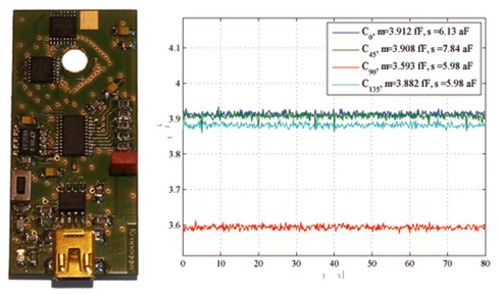In order to asses the quality of a blade, it should be possible to determine the radius of curvature based on its electrical field distribution.
Deviations of just a few micrometer, can cause capacitance variations in the range of a few attofarad. The goal of this thesis is the determination of the best achievable precision of the utilized sensor electronics.
For this purpose a measurement setup with four capacitances, which provides the possibility of measuring capacitance variations in the aF range, was implemented. During the development of the measurement device, various possibilities for interference rejections were examined and as a result ground surface shielding was chosen.
 Figure 1: Left: capacitance measurement device; right: measurement series of four sensors, with air as dielectric.
Figure 1: Left: capacitance measurement device; right: measurement series of four sensors, with air as dielectric.
Since the measurement capacitances themselves are smaller that the specified precision of the sensor, the measurement results are subjected to a notable measurement bias error. Therefore, it was not possible to confirm the measurement results by means of simulation. To provide comparability between measurement and simulation, a calibration of the sensors was performed, using different dielectrics.
The results of the initial measurements of the capacitances show, that capacitances can be determined with a resolution of 6 aF. A very good compliance of measurement and simulation was achieved through sensor calibration. For sensitivity assessment, the measurement of the capacitance variation caused by the dielectric was confirmed through simulation.
Keywords: capacitance to digital converter, shielding, precision measurement, sensibility, ECT
May 03, 2013